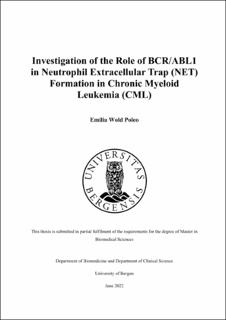| dc.description.abstract | Neutrophil extracellular traps (NETs) represent a rather newly discovered antimicrobial mechanism first described by Brinkmann and co-workers in 2004. NETs are extracellular structures composed of decondensed chromatin decorated with granule proteins released from neutrophils to trap and kill invading microorganisms. In addition to their role in defense, excessive NET formation has been linked to the pathogenesis of several diseases including cardiovascular diseases, autoimmune diseases (e.g. lupus erythematous), infectious diseases (e.g. sepsis and covid-19), and cancer. However, the role of NETs in chronic myeloid leukemia (CML) has been sparsely explored. More information about the involvement of NETs in CML may provide increased understanding with respect to disease development and response to current therapy consisting of tyrosine kinase inhibitors (TKIs). Also, additional knowledge about NETs in general could facilitate potential development of novel anti-NET therapeutics. In this thesis, the NET forming capabilities of a CML cell line model and neutrophils isolated from CML patients together with the effects of tyrosine kinase inhibitors were investigated. The CML cell line Kcl-22 was intended used as a model system for NET formation in CML. First for the generation of neutrophils through cell differentiation followed by induction of these differentiated cells to produce NETs. However, it was discovered that the Kcl-22 cells did not differentiate towards neutrophils, although, subsequent detection of NET-like structures was observed in the Kcl-22 cell line after exposure to various differentiation agents and the NET stimulation compounds PMA and ionomycin. Successful induction of extracellular traps (ETs), decreased expression of CD15, and increased expression of CD33, together with an overall lack of segmented nuclei, suggested that these cells most likely had differentiated towards mast cells and that the ETs observed were mast cell extracellular traps (MCETs). In primary neutrophils, isolated from the peripheral blood of CML patients, NETs were observed ex vivo, both with and without exposure to stimulating agents. NET formation capacity of primary neutrophils derived from CML patients was compared to neutrophils derived from healthy individuals. Through immunofluorescence and fluorescence microscopy NETs formed by neutrophils from CML patients appeared increased in number and size compared to neutrophils from healthy donors. In addition, attempts to quantify NETs in primary neutrophils, by ELISA and manual counting, were performed comparing NET formation in neutrophils from CML patients to neutrophils from healthy donors to detect differences. BCR-ABL1 is the hallmark and oncogenic driver of CML and was investigated for a potential role in NET formation. The BCR-ABL1 activity, measured by phospho-BCR-ABL1, was demonstrated to be completely inhibited by treatment with the TKIs ponatinib and ABL001 in Kcl-22 cells, however, their capability to form ETs was not affected. Additionally, no altered NET formation was observed in primary neutrophils derived from one CML patient after TKI treatment. Together, this indicated that BCR-ABL1 does not play a direct role in NET formation. In conclusion, this thesis has shown that CML cells can form extracellular traps and that BCR-ABL1 does not seem to influence the amount of NET formation in CML primary neutrophils or ET formation in the Kcl-22 cell line. | |
